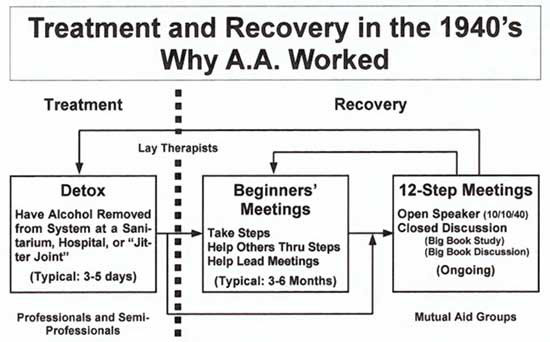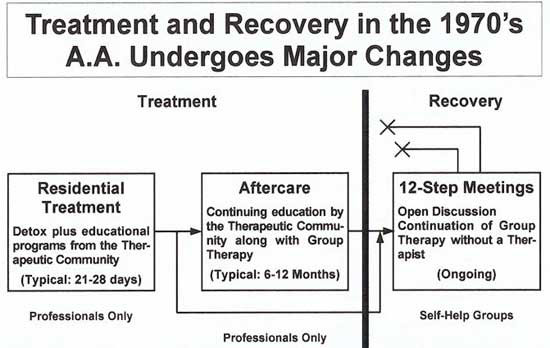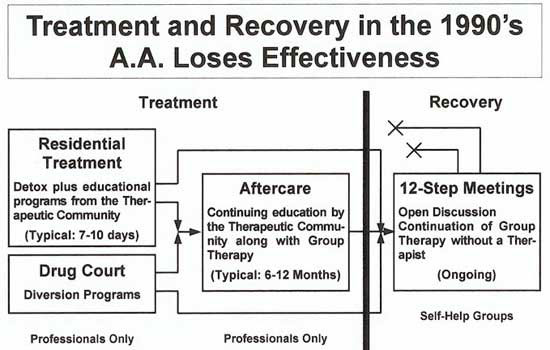For the past several years, Wally P. has been conducting seminars on the success of the Beginners' Meetings during the early days of Alcoholics Anonymous. He has used a series of schematics to emphasize his findings and conclusions. Now, he has made these pictorial representations available for anyone in the fellowship to view and comment on.

A Spiritual Program of Action
Treatment for alcohol addiction in the 1940's consisted of a three to five day withdrawal process in a sanitarium, hospital or "jitter joint" where the patient was safely detoxed from the bodily effects of alcohol. The process of withdrawal management was conducted by health professionals and semi-professionals. Moreover, these facilities were receptive and worked with recovered members of Alcoholics Anonymous.
After detox, the "dry" alcoholic would be directed to Alcoholics Anonymous where the "dry drunk" would be directed to a "Beginners' Meeting". There the recovering alcoholic would take the A.A. 12 Step Program and learn how to help others through the 12 Steps and help lead meetings taking approximately three to six months lay treatment (alcoholics helping alcoholics) for alcoholism.
On-going mutual aid support was provided by the A.A. fellowship through meetings that were either, big book study, big book discussion, or Open Speaker meetings base on the 10 minutes of "What we were like", 10 minutes on "What happened", and 40 minutes on "What we are like today". It worked! Recovery rates were 50 to 75 percent successful, in fact, in Cleveland they were as high as 75 to 93 percent successful. These statistics were written in 1955 in the Forward to the Second Edition of the Big Book of Alcoholics Anonymous.
Of alcoholics who came to A.A. and really tried, 50% got sober at once and remained that way; 25% sobered up after some relapses, and among the remainder, those who stayed on with A.A. showed improvement. Other thousands came to a few A.A. meetings and at first decided they didn't want the program. But great numbers of these--about two out of three--began to return as time passed. (p. xx, A.A. 4th Edition)
Furthermore, membership in A.A. meant complete abstinence from alcohol. If you couldn't stay sober, you were no long a member! Thus the A.A. rooms of the 1940's were full of recovered alcoholics sharing experience, strength and hope to newly indoctrinated members. (Unlike today where the 12 Step rooms are filled with chronic relapsing alcoholics and addicts who have a revolving door membership with the local withdrawal management centers.)
In the September 1945 issue of the Grapevine...
The Genesee Group in Rochester, NY explained their format for taking newcomers through the Steps. The title of the article was "Rochester Prepares Novices for Group Participation". This is how they perceived the recovery process to operate most efficiently: "It has been our observation that bringing men [and woman] into the group indiscriminately and without adequate preliminary training and information can be a source of considerable grief and a cause of great harm to the general moral of the group itself. We feel that unless a man, after a course of instruction and an intelligent presentation of the case for the A.A. life, has accepted it without any reservation he should not be included in group membership. When the sponsors feel that a novice has a fair working knowledge of A.A.'s objectives and sufficient grasp of it's fundamentals then he is brought to his first group meeting.
In the A.A. Washington, Pa., Bulletin, April 1949, it stated...
"When Bill W. got the 'jitters' out in Akron (back in 1935), he couldn't call another A.A. to furnish cry-on-my-shoulder service. There weren't any other AAs. So he called -- and called -- until he found a drunk who needed help.
"He finally found 'Doc,' and in helping 'Doc' he forgot his own troubles and stayed sober. If that prescription worked for the founder of our fellowship, and it did, then it will work for us today. So, instead of always looking up an AA who is staying sober to give us a lift in spirit, it might help all of us to use Bill's 'prescription' once in a while and find a drunk who needs help. Let us not lose sight of one of the cardinal principles of A.A. -- 'To help ourselves, we help others.'"

From "Into Action" to "Open Discussion" -- The birth of the "Open Disgusting Meeting"
Hear renowned Big Book, AA / CA speaker, Chris R. talk about the problem with Alcohol and Drug Treatment Programs. |
Hear renowned Big Book, AA / CA speaker, Chris R. talk about how AA buckled under the weight of Alcohol and Drug Treatment Programs. |
In the 1970's, the A.A. program underwent a major change and recovery rates plummeted. Why? The proliferation of alcohol and drug treatment facilities throughout the 70's and 80's, financed by insurance company plans whose medical and psychological approaches pushed out the more traditional A.A. tenets that called for total surrender to a higher power, coupled with service to others, changed our message from a spiritual program of action to a self-help program of discussion."
The 12 Step Program as described in the Big Book of Alcoholics Anonymous changed from a simple spiritual program of action and was replaced by the treatment center industry with a long drawn out process of endless sharing and discussion in group therapy coupled, cognitive behaviour education, relapse prevention theory -- all of which is facilitated by paid professional therapists and drug addiction counsellors, many of whom were not even alcoholics or addicts! Moreover, the therapeutic/treatment community separated itself from the lay recovered alcoholics/addicts, making treatment a separate program that in many respects was contrary and even antagonistic towards the 12 Step Spiritual program of action.
The Big Book of Alcoholics Anonymous says...
As we discovered the principles by which the individual alcoholic could live, so we had to evolve principles by which the A.A. groups and A.A. as a whole could survive and function effectively...there was to be no professional class of therapy. (p. xix, A.A. 4th Edition)
The therapeutic/treatment community is responsible for many of the subtle but damaging changes to the 12 Step fellowship such as:
- Changing the declaration of "I am a member of Alcoholics Anonymous" (which meant you practiced continuous abstinence from alcohol) to the utterance of "I am a recovering alcoholic", perpetuating and reinforcing the alcoholic/addict disease.
- In the 1940's, meetings would close with a solemn Lord's prayer. There was no hand-holding or chanting with all that "granola" pap uttered in the rooms today.
- God was replaced by the term "higher power". This was necessary in order to get money from government programs which mandated a NO God message. This has contributed greatly to the secularization of many of the 12 Step programs.
- There were also no readings in the early days. The fellowship got down to business right away with either a speaker (10/10/40 format) or Big Book discussion and there was certainly no poetry such as"Yesterday, Today and Tomorrow" or the "The Man in the Glass", which were, once again introduced by the Treatment Center industry.
- The attitude of entitlement to "share" on ones feelings and issues in the 12 Step rooms today. In the 1940's if an alcoholic/addict had not worked the 12 Steps, they were told to "shut up" because they had nothing to share expect their drunk-a-logs. The meetings were solution oriented NOT "war-story" meetings.
Furthermore, many of those mandated into treatment by their employers were not even real alcoholics or addicts! Just because an employee wore a lamp shade on their head at the office Christmas party and acted like an "ass" and leading the boss to think they may have a drinking problem does NOT make them an alcoholic! The ensuing result -- A.A. grew in numbers in the 1970's and our fellowship became inundated with hard-drinkers and users sharing their treatment center rhetoric. You can easily identify these types in our fellowship -- they are the ones that never had to work the 12 Steps -- their mantra is "Meeting Makers Make It!" The "real" alcoholics and addicts, who have ventured to the realm of being beyond human aid failed to find the necessary power with the psychological approach or behavioural modification as a treatment strategy. The record shows that chronic relapsers have continuously shown they cannot stay sober on alcohol and drug treatment programs alone. And, to add insult to injury chronic relapsers are often told by these treatment center program graduates that they (the "real" alcoholics and addicts) obviously do not want sobriety bad enough!
The Big Book of Alcoholics Anonymous says...
A certain American business man had ability, good sense, and high character...he had floundered from one sanitarium to another. He had consulted the best known American psychiatrists. Then he had gone to Europe, placing himself in the care of a celebrated physician (the psychiatrist, Dr. Jung) who prescribed for him...he finished his treatment with unusual confidence. His physical and mental condition were unusually good. Above all, he believed he had acquired such a profound knowledge of the inner workings of his mind and its hidden springs that relapse was unthinkable. Nevertheless, he was drunk in a short time. More baffling still, he could give himself no satisfactory explanation for his fall. So he returned to this doctor, whom he admired, and asked him point-blank why he could not recover. He wished above all things to regain self-control. He seemed quite rational and well- balanced with respect to other problems. Yet he had no control whatever over alcohol. Why was this? He begged the doctor to tell him the whole truth, and he got it. In the doctor's judgment he was utterly hopeless; he could never regain his position in society and he would have to place himself under lock and key or hire a bodyguard if he expected to live long. That was a great physician's opinion. (p. 26, A.A. 4th Edition)
But there was always the curious mental phenomenon that parallel with our sound reasoning there inevitably ran some insanely trivial excuse for taking the first drink (or drug). Our sound reasoning failed to hold us in check. The insane idea won out. Next day we would ask ourselves, in all earnestness and sincerity, how it could have happened. (p. 37, A.A. 4th Edition)
That may be true of certain nonalcoholic people who, though drinking foolishly and heavily at the present time, are able to stop or moderate, because their brains and bodies have not been damaged as ours were. But the actual or potential alcoholic, with hardly any exception, will beabsolutely unable to stop drinking on the basis of self-knowledge. (p. 39, A.A. 4th Edition)
Thanks to the "good intentioned" treatment industry, our 12 Step rooms today are full of the "blind leading the blind". Residential treatment and aftercare, which could take upwards to a year to complete replaced the three to five day detox program of the 1940's. Indoctrinated by the professional therapeutic/treatment community, large numbers of potential alcoholics/addicts infiltrated the A.A. fellowship changing our Big Book/Speaker meeting format to "Open Discussion" meetings better known as "group therapy without a therapist". The result? Our recovery rates went down the toilet to less than 5% success rates -- so much so that a real alcoholic/addict was better off trying to sober up on his own accord rather than attend an A.A. or N.A. program.

Ironically, insurance company cutbacks in the early '90s that reduced treatment center stays to less than a week may have led to the resurrection of Beginners' Classes. "There have been 500 to 700 primary treatment center closures in the last five or ten years," says John Curtiss, executive director of the Hazelden Renewal Center in the Center City, Minn.
However, Treatment Centers (a.k.a. "Puzzle-Factories") continue to flourish under government sponsored programs with mandated "Drug Court" ("Get Out of Jail Free" strategy), Anger Management Classes, Aftercare Programs, Mental Health Programs, Life-skills Programs and countless other government financed social programs. Ineffective strategies and attitudes still prevail in the 12 Step rooms such as:
- "You only work one step a year" "Take your time to work the steps",
- "Keep coming back, eventually it will rub off on you",
- "This program is caught not taught",
- "Play the tape all the way through",
- "Think through the drink" -- "Remember When" -- "Remember your last drunk"
- "I choose not to drink today",
- "I will always be recovering, never recovered",
- "I'm feeling pretty crappy. I need a meeting",
- "Don't drink and go to meetings",
- "I'm powerless over people, places and things",
- "We must change playmates, playgrounds, and playthings" -- "Avoid people, places and things that you associate with alcohol or drugs",
- "I have a choice to not drink today",
- "Your Higher Power can be whatever you want It to be; a door knob, a Dr. Pepper can, a light bulb, just any old thing",
- "Don't make any major decisions for the first year",
- "Stay out of relationships for the first year",
- "We learn to live life on life's terms",
- "There are no musts in this program" -- "Take what you need and leave the rest",
Cliff B., Dallas, TX, a recovered alcoholic explains what we need to do...
There is a tendency to want to place the blame for our predicament on the treatment industry and professionals. They do what they do and it has nothing to do with what we do in Alcoholics Anonymous. What they do is their business. That is not where to place the blame and also to do so is in violation of our Tenth Tradition. The real problem is that the members of Alcoholics Anonymous, who were here when the "clients" began coming to our Fellowship did not help the "clients" understand that our Program had been firmly established since April 1939, and that the guidelines for the preservation and growth of our Fellowship were adopted in 1950. They weren't told that they must get rid of their new "old ideas" and start practicing the Twelve Step Program of Alcoholics Anonymous as it was given to us. They weren't informed that until they had taken the Steps and recovered, they had nothing to say that needed to be heard except by their sponsor. But that didn't happen. To the contrary, the old-timers failed in their responsibility to the newcomer to remind them of a vital truth, "Rarely have we seen a person fail who has thoroughly followed our path. Those who do not recover are people who cannot or will not completely give themselves to this simple program." "Rarely have we seen a person fail" to "Seldom do we see a person recover."
We have permitted untreated alcoholics and non-alcoholics to sit in our meetings and lay out their problems, ideas and opinions. We have gone from, "Rarely have we seen a person fail" to "Seldom do we see a person recover." So there we have it. We have had 30 years of unbelievable success by following the directions in the Big Book. We have had 30 years of disappointing failure by wanting to hear from everyone. We now have something to compare. We now know what the problem is and we now know what the solution is.
Unfortunately, we have not been prompt to correct the faults and mistakes, which have been created by what would appear to be large doses of apathy and complacency. The problem we are trying to live with is needlessly killing alcoholics. The Solution? The Power greater than ourselves, that we find through our Twelve Steps, promises recovery for those who are willing to follow the clear cut directions found in the Big Book.

No comments:
Post a Comment